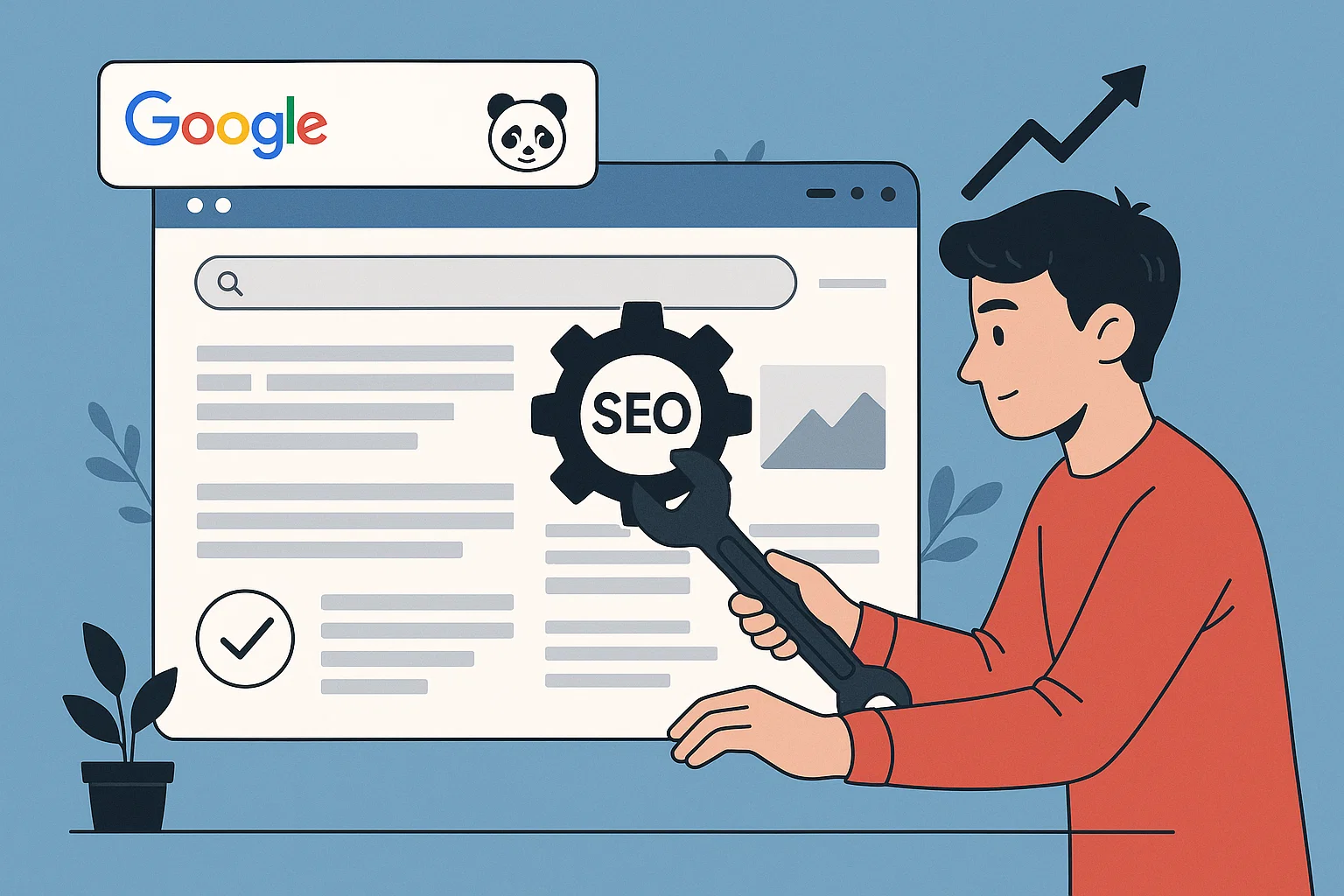
Let’s be real. Nothing feels worse than pouring your heart into a blog post only to see Google bury it on page 5 because of an update you didn’t even know existed. But here’s the twist: Panda isn’t out to get you. It’s out to get bad content. So if you’re smart, creative, and willing to tweak your SEO game, Panda can actually push you higher , while your competitors disappear into the search engine abyss.
This guide isn’t about boring theory. It’s about saving your site from Google Panda, surviving future updates like Penguin and Hummingbird, and making your SEO stronger than ever.
Why Google Panda Still Matters
Quick history check: Google rolled out Panda back in 2011 to clean up search results. Before Panda, the internet was full of junk , think article farms, spammy keyword-filled posts, and content copied ten times across shady sites. People were gaming the system, and Google was losing trust.
Enter Panda. Its mission? Reward quality content, punish thin or duplicate stuff.
Now, you might be wondering: “But isn’t Panda old news? Don’t we have new updates like Penguin or Hummingbird?” Yep, but here’s the catch: Panda got baked right into Google’s core algorithm. That means it never left. It’s like the DNA of how Google decides what’s quality and what’s trash.
So, if your site isn’t Panda-proof, you’ll keep feeling its bite , quietly, consistently, and painfully.
What Panda Actually Looks For
Here’s the scary but honest truth: Panda doesn’t care about your effort; it cares about your signals.
Some red flags Panda hunts down:
Thin content – Short, low-value posts that don’t really help anyone.
Duplicate articles – Copy-paste jobs or the same topic rehashed without originality.
Keyword stuffing – Writing like a robot: “best cheap laptop laptop cheap laptop buy laptop.” Yeah, Panda hates that.
Poor user signals – People clicking back to Google too fast (high bounce rate = “your content sucks”).
Content farms – Too many low-quality pages written just to rank.
And here’s a fun fact: remember the Google Panda game that used to trend online? It was literally a joke about how unpredictable the update felt. But the message was serious: if your site’s quality sucked, Panda would crush it.
Real Consequences of Panda
Still think it’s no big deal? Let’s paint a picture. 
Imagine you’re pulling in 10,000 visitors a day from organic traffic. Adsense is paying the bills, maybe even covering your rent. Then Panda hits. Overnight, you’re down 60–70%. Your revenue tanks. You scramble, but by then, it’s too late.
That’s not a horror story , it’s what happened to thousands of bloggers and small businesses back in the first Panda update. Some never recovered. Others reinvented their content strategy and came back stronger.
You want to be in that second group.
Step 1: Fix Content Quality
Here’s the golden rule: write for people, not for Panda.
If you’re pushing out short, recycled posts, stop. Right now. Google’s algorithm is smarter than ever, and it can smell lazy content from miles away.
What works instead?
Go deep. Don’t just answer the “what.” Answer the “why” and “how.” If your post is about the Penguin update in SEO, explain it with examples, history, and real-life impact.
Use LSI keywords. Sprinkle in terms like Google penguin update, hummingbird update in SEO, panda update in SEO naturally. It helps Google understand context.
Add value. Tables, FAQs, infographics, quotes , they all make content more useful.
Think about it like this: if your content can’t beat the top three results on Google in helpfulness, why would Panda give you a pass?
Step 2: Clean Up Duplicate & Thin Pages
Panda hates clones.
Check for duplicate content. Tools like Copyscape or even free plagiarism checkers can save you.
Merge similar posts. Got three posts about “how to update SEO on Google”? Combine them into one epic guide.
No-index the junk. Tag pages, old archives, thin affiliate pages , if they’re not useful, tell Google to ignore them.
And here’s where creativity helps. If you must rewrite old content, don’t just reword it. Add personality. Bring in a new angle. Even use a Paraphrasing Tool or AI reword tool as a helper, but always finish with your own unique touch.
Step 3: Improve User Signals
Google Panda doesn’t just read words. It watches how people interact with them.
Bounce rate. If users leave in 3 seconds, Google assumes your content didn’t deliver.
Time on site. Longer is better. That means more storytelling, more visuals, and tighter flow.
Engagement. Comments, shares, links , these all tell Panda, “Hey, people like this.”
Pro tip: Add sections like FAQs or mini-guides inside your articles. Readers stay longer because they find exactly what they need.
Step 4: Technical SEO Basics
Don’t ignore the boring stuff. Panda might be content-focused, but technical SEO matters too.
Speed up your site. A slow page = higher bounce rate.
Mobile-first design. Most readers are on phones. If your site breaks, Panda frowns.
Proper indexing. Use Google Search Console to make sure important pages are being crawled.
This is where Penguin and Hummingbird overlap. Penguin watches for spammy backlinks; Hummingbird cares about context and natural language. Together with Panda, they’re like Google’s Avengers team , each covering a piece of the SEO puzzle.
Step 5: Stay Ready for Penguin & Hummingbird
So, what’s the difference?
| Update | Main Focus | What To Do |
|---|---|---|
| Panda | Content quality, duplicates | Write long, unique, valuable posts |
| Penguin | Backlink quality | Avoid spammy links, build trust links |
| Hummingbird | Context + natural language search | Use conversational tone, answer real queries |
Think of it like this: Panda checks your writing, Penguin checks your friends (backlinks), and Hummingbird checks your brain (intent). If you fail at one, your rankings suffer.
Creative SEO Hacks to Stay Ahead
Here’s where you can have some fun. Panda doesn’t just want quality , it rewards creativity.
Tell stories. Instead of saying “How to save from Google Panda update SEO tips,” share a story of a blogger who lost 70% of traffic, then recovered by cleaning up content.
Add personality. Use your voice. Don’t sound like a textbook.
Mix formats. Add videos, podcasts, or even interactive quizzes. Google loves variety.
Update old posts. A two-year-old SEO tip looks stale. Refresh it with new examples, and Panda sees you as alive and relevant.
Remember: creativity isn’t fluff. It’s a survival strategy.
Final Thoughts
Here’s the truth most SEO gurus won’t tell you: Google Panda isn’t your enemy. It’s actually your filter against lazy competition. Every update, from Panda to Penguin to Hummingbird, is Google’s way of cleaning house. If you focus on originality, value, and user happiness, Panda will end up being your biggest ally.
So instead of fearing the update, embrace it. Write better, dig deeper, stay creative , and let the junk sites vanish while yours climbs.
If you’re sitting on old posts, now’s the time to update them. And if you’re starting fresh, build Panda-proof habits from day one. Trust me, your future self (and your traffic) will thank you.

Mia Creatives explores the intersection of technology and creativity. Dive into WordPress, SEO, and innovative ways to thrive online.